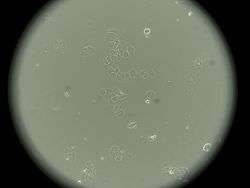MCF-7
MCF-7 is a breast cancer cell line isolated in 1970 from a 69-year-old Caucasian woman.[1] MCF-7 is the acronym of Michigan Cancer Foundation-7, referring to the institute in Detroit where the cell line was established in 1973 by Herbert Soule and co-workers.[2] The Michigan Cancer Foundation is now known as the Barbara Ann Karmanos Cancer Institute.[3]

Prior to MCF-7, it was not possible for cancer researchers to obtain a mammary cell line that was capable of living longer than a few months.[4]
The patient, Frances Mallon died in 1970. Her cells were the source of much of current knowledge about breast cancer.[2][5] At the time of sampling, she was a nun in the convent of Immaculate Heart of Mary in Monroe, Michigan under the name of Sister Catherine Frances.
MCF-7 and two other breast cancer cell lines, named T-47D and MDA-MB-231, account for more than two-thirds of all abstracts reporting studies on mentioned breast cancer cell lines, as concluded from a Medline-based survey.[6]
Characteristics of MCF-7 cells
MCF-7 cells have the following characteristics:[2][5][6][7][8][9]
- Primary tumor (invasive breast ductal carcinoma)
- Originate from pleural effusion
- Estrogen receptors present[10]
- Proliferative response to estrogens
- Presence of progesterone receptors
- Cannot have ERBB2 gene amplification (with Her2/neu protein overexpression)
- Tumorigenic in mice but only with estrogen supplementation if engrafted into the subcutaneous fat or mammary fat pad
- Tumorigenic in mice without estrogen supplementation if engrafted intraductally[11]
- Luminal epithelial phenotype
This cell line retained several characteristics of differentiated mammary epithelium, including the ability to process estradiol via cytoplasmic estrogen receptors and the capability of forming domes.
Tumor necrosis factor alpha (TNF alpha) inhibits the growth of MCF-7 breast cancer cells. Treatment with anti-estrogens can modulate the secretion of insulin-like growth factor binding proteins. Omega-3 and 6 fatty acids such as EPA, DHA and AA has been reported to inhibit MCF-7 cell line growth and proliferation.[12]
PIK3CA helical mutations were identified in MCF-7,[13] but with low AKT activation.[14]
References
- Lee, Adrian V.; et al. (1 July 2015). "MCF-7 Cells—Changing the Course of Breast Cancer Research and Care for 45 Years". Journal of the National Cancer Institute. 107 (7): djv073. doi:10.1093/jnci/djv073. PMID 25828948.
- Soule, HD; Vazquez J; Long A; Albert S; Brennan M. (1973). "A human cell line from a pleural effusion derived from a breast carcinoma". Journal of the National Cancer Institute. 51 (5): 1409–1416. doi:10.1093/jnci/51.5.1409. PMID 4357757.
- http://www.cancer.gov "Archived copy". Archived from the original on 2010-05-27. Retrieved 2010-04-28.CS1 maint: archived copy as title (link) Retrieved on 2010-04-28
- Glodek, Cass, Ph.D., "A History of the Michigan Cancer Foundation, the Beginnings & Growth of Detroit's Anticancer Movement," 1990, page 68, Michigan Cancer Foundation, Detroit.
- Levenson, AS; Jordan VC. (1997). "MCF-7: the first hormone-responsive breast cancer cell line". Cancer Research. 57 (15): 3071–3078. PMID 9242427.
- Lacroix, M; Leclercq G. (2004). "Relevance of breast cancer cell lines as models for breast tumours: an update". Breast Research and Treatment. 83 (3): 249–289. doi:10.1023/B:BREA.0000014042.54925.cc. PMID 14758095.
- Ross, DT; Perou CM. (2001). "A comparison of gene expression signatures from breast tumors and breast tissue derived cell lines". Disease Markers. 17 (2): 99–109. doi:10.1155/2001/850531. PMC 3850857. PMID 11673656.
- Charafe-Jauffret, E; Ginestier C; Monville F; Finetti P; Adelaide J; Cervera N; Fekairi S; Xerri L; Jacquemier J; Birnbaum D; Bertucci F. (2006). "Gene expression profiling of breast cell lines identifies potential new basal markers". Oncogene. 25 (15): 2273–2284. doi:10.1038/sj.onc.1209254. PMID 16288205.
- Lacroix, M; Toillon RA; Leclercq G. (2006). "p53 and breast cancer, an update". Endocrine-Related Cancer. Bioscientifica. 13 (2): 293–325. doi:10.1677/erc.1.01172. PMID 16728565.
- Fanelli, Alex (2016). "MCF-7 Cells: human breast adenocarcinoma cell line". Retrieved 3 December 2017.
- Sflomos, George; Dormoy, Valerian; Metsalu, Tauno; Jeitziner, Rachel; Battista, Laura; Scabia, Valentina; Raffoul, Wassim; Delaloye, Jean-Francois; Treboux, Assya (2016). "A Preclinical Model for ERα-Positive Breast Cancer Points to the Epithelial Microenvironment as Determinant of Luminal Phenotype and Hormone Response". Cancer Cell. 29 (3): 407–422. doi:10.1016/j.ccell.2016.02.002. PMID 26947176.
- Mansara, Prakash P.; Deshpande, Rashmi A.; Vaidya, Milind M.; Kaul-Ghanekar, Ruchika (1 September 2015). "Differential Ratios of Omega Fatty Acids (AA/EPA+DHA) Modulate Growth, Lipid Peroxidation and Expression of Tumor Regulatory MARBPs in Breast Cancer Cell Lines MCF7 and MDA-MB-231". PLOS ONE. 10 (9): e0136542. doi:10.1371/journal.pone.0136542. ISSN 1932-6203. PMC 4556657. PMID 26325577.
- Cosmic. "COSMIC: Sample overview for 1289391". cancer.sanger.ac.uk. Retrieved 2017-05-10.
- Vasudevan, Krishna M.; Barbie, David A.; Davies, Michael A.; Rabinovsky, Rosalia; McNear, Chontelle J.; Kim, Jessica J.; Hennessy, Bryan T.; Tseng, Hsiuyi; Pochanard, Panisa (2009-07-07). "AKT-independent signaling downstream of oncogenic PIK3CA mutations in human cancer". Cancer Cell. 16 (1): 21–32. doi:10.1016/j.ccr.2009.04.012. ISSN 1878-3686. PMC 2752826. PMID 19573809.
External links
| Wikimedia Commons has media related to MCF-7 cells. |